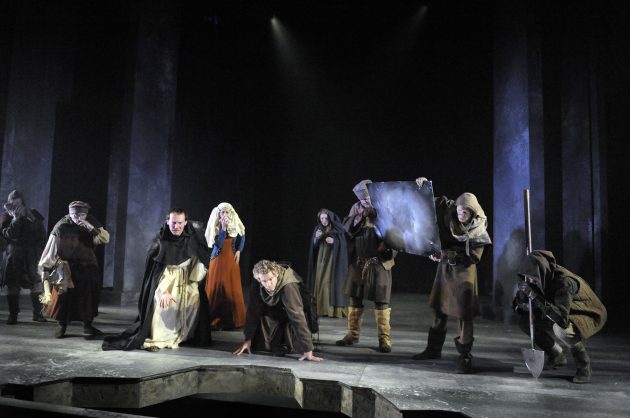The Spire is without doubt my favourite William Golding novel. I love the beauty of the symbolism and the way Golding plays with narrative techniques to chart Dean Jocelin’s descent into madness. I was, therefore, really excited to hear that Salisbury Playhouse was to present the first ever stage adaptation of The Spire. This of course has particular local significance because the construction of the spire in the novel was inspired by the real-life spire on Salisbury Cathedral. Golding taught at Bishop Wordsworth’s School in Salisbury (beside the cathedral) before becoming a full-time writer.
Prior to the viewing the play, I was intrigued as to how the set designers and director would portray the building of the spire. Golding describes the construction in great detail at times, and we get a sense in the book of the noise, smell and disturbance that the builders bring to the peaceful atmosphere. Could this be replicated on stage? The other challenge is that most of the action occurs in Jocelin’s mind and he is such an unreliable narrator that often the reader isn’t sure whether Jocelin’s version of events is correct.
Of course, the stage could not realistically portray the building of a 400-foot spire, on top of an already massive cathedral! However, the set was imaginatively designed to show the construction of various stages and eerie choral music accompanied set changes enhancing the atmosphere of the play. ‘The pit’ was impressively hidden on the stage until it was revealed to the characters to show how the earth under the cathedral was ‘creeping’. The pillars are present for much of the performance and ‘sing’ when the weight of the spire becomes too much.
Perhaps the best aspect of ‘The Spire’ are the performances. Mark Meadows plays Dean Jocelin and his fine performance adds nuance to Jocelin’s increasingly unravelling mind. The scene where Lady Alison (Sarah Moyle) tells Jocelin that he was not chosen by God – that it was in fact Lady Alison who persuaded the King during an affair that Jocelin should be promoted – is unbearably tense. Jocelin’s realisation that he was merely a pawn in their game is devastating and beautifully played by Meadows. It is here that the audience, and Jocelin himself, finally understands the ‘cost’ of Jocelin’s vision and unshakeable pride.
Roger Spottiswoode, director of films including The 6th Day and Tomorrow Never Dies, adapted the script for the play from Golding’s novel. He adds welcome contextual detail to characters like Goody Pangall and shows the development of the affair between Goody and the master builder, Roger Mason, who is impressively played by Vincenzo Pellegrino. Spottiswoode’s biggest challenge is to reflect Jocelin’s unstable narration and for the most part, he succeeds. For instance, Golding never makes the outcome explicit when Pangall is killed by the workmen at the end of chapter four. Jocelin just won’t accept what he has seen and rages at Pangall for running off and leaving Goody. In Spottiswoode’s adaptation, Pangall’s murder is also never quite confirmed. We see the builders attacking Pangall in a series of tableaux punctuated with dramatic lightning – a wonderful achievement from sound designer Tom Gibbons and lighting designer Philip Gladwell. After this scene at the end of Act 1, Jocelin frequently chides Pangall to other characters for leaving Goody, particularly as she is pregnant (although Jocelin really knows that Pangall isn’t the father).
This is an ambitious production, which manages to capture the bleakness of Golding’s novel. The playhouse’s location – so close to Golding’s inspiration – contributes immensely to its outstanding achievement. Highly recommended!
Picture credit: Keith Pattinson. Salisbury Playhouse production of THE SPIRE by William Golding
adapted by Roger Spottiswoode directed by Gareth Minchin


